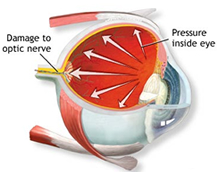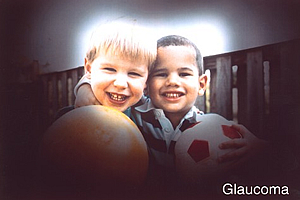What is Glaucoma?
Glaucoma, often called the "sneak thief of sight," is a disease that strikes without any obvious symptoms. You usually don't know it's there until serious vision loss has occurred. And unfortunately, there is no cure for glaucoma. Once you have lost your vision, it can't be restored.
The good news is that glaucoma can be detected early before there is any vision loss. Plus, there are convenient treatments that can lower intraocular pressure (IOP), one of the major risk factors for glaucoma.
The keys to managing diseases that cause vision loss are early diagnosis, proper treatment, and regular eye exams. Your eye doctor has ways to assess your risk for developing glaucoma and can prescribe treatments to help prevent or delay vision loss if you have glaucoma.
 Glaucoma is an eye disease that involves damage to the optic nerve, which sends visual signals to the brain. No one knows exactly what causes this damage, but pressure buildup in the eye is proven to be one of the major risk factors associated with glaucoma. Glaucoma is an eye disease that involves damage to the optic nerve, which sends visual signals to the brain. No one knows exactly what causes this damage, but pressure buildup in the eye is proven to be one of the major risk factors associated with glaucoma.
The front of the eye is filled with a liquid called aqueous humor. This is produced by the eye to bathe and nourish its different parts. The aqueous humor normally flows out of the eye through various paths and chambers. When these paths get clogged, aqueous humor gets trapped in the eye. This causes a pressure buildup and leads to high IOP. When the optic nerve gets damaged by high IOP's, some signals from the eye aren't transmitted to the brain. This can result in visual field loss, and if not managed, could eventually lead to blindness.
There are two basic types of glaucoma:
Primary Open Angle Glaucoma (POAG), the most common form which accounts for about 80% of all cases, happens when the eye's drainage canals get clogged over time. The intraocular pressure (IOP) rises because the correct amount of fluid can't drain out of the eye, causing a gradual vision loss. POAG develops very slowly and sometimes without noticeable sight loss.
Angle Closure Glaucoma, also known as acute glaucoma or narrow angle glaucoma, is mush rarer. If the iris and cornea are not as wide and open as they should be, the outer edge of the iris bunches up over the drainage canals when the pupil enlarges too much or too quickly, such as when entering a dark room, thus causing blockage of the drainage canals and an increase in IOP.
Could you be at risk?
Glaucoma is one of the most common causes of preventable blindness. Over 3 million Americans have glaucoma, yet only half of them are aware they have it. One out of every five sufferers has a close relative with it. In the United States, approximately 120,000 people are living with blindness due to glaucoma.
Some people are at greater risk than others. You are at greater risk for glaucoma:
- If you are over age 40
- If you have abnormally high IOP's
- If you have a family history of glaucoma
- If you are of African, Scandinavian, Celtic, or Russian ancestry
- If you have diabetes
- If you are nearsighted
- If you have used steroids and/or cortisone
- Previous eye injury
 |
| A scene as it might look to a person with glaucoma. Glaucoma has been nicknamed "the sneak thief of sight" because it often goes undetected and causes irreversible damage to the eye. |
If you have any of these risk factors, it is important that you get regular eye checkups. One of the most common and important tests for measuring IOP is tonometry. Tonometry is a procedure in which your doctor uses a tonometer to measure IOP. Tonometry is a painless test and takes only a few seconds to perform.
Normal IOP is about 12 to 22mm Hg (millimeters of mercury, which is the unit used to measure IOP). However, high IOP does not necessarily mean you will have glaucoma, nor does normal IOP mean you don't have glaucoma. Controlling IOP is the major goal of glaucoma therapy. When IOP is controlled, the optic nerve is less at risk of being damaged, so vision may be preserved. Early detection and treatment of glaucoma can slow the disease's progression and help prevent blindness.
What are the Symptoms of Glaucoma?
People who have glaucoma often do not experience symptoms until they begin to lose their peripheral (side) vision, which is why glaucoma has become known as “the silent thief of sight.” As glaucoma progresses, some of the following warning signs may be present:
- Loss of peripheral vision
- Headache or blurred vision
- Difficulty or inability to adjust vision in dark rooms
- Difficulty focusing on close work
- Halos or colored rings around lights
- Frequent need to change eyeglass prescriptions
Visual loss that results from glaucoma is permanent and irreversible. If you are experiencing any of these symptoms of glaucoma, contact us at Bay Eyes right away to schedule a comprehensive eye exam.
Treatments Available
:: SLT
:: ECP
:: YAG PI
|





